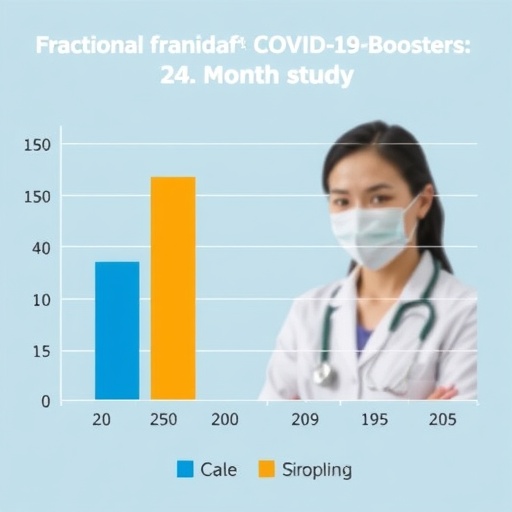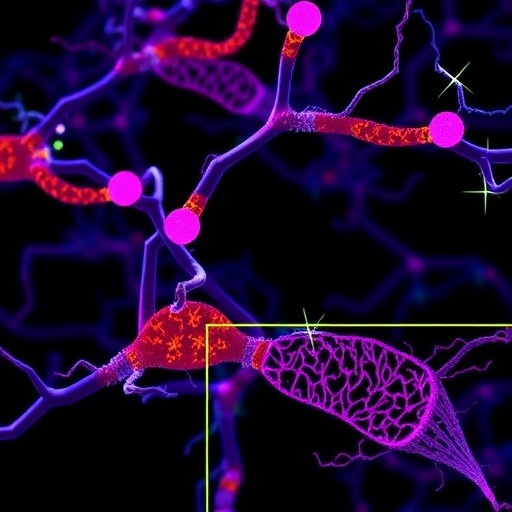In a groundbreaking longitudinal study published in Nature Communications, researchers have unraveled vital insights into the immunogenicity of fractional versus standard dose COVID-19 vaccine boosters among healthy adults in Indonesia. This extensive study follows vaccine recipients over a remarkable 24-month timeline, providing one of the most comprehensive datasets to date on the durability and effectiveness of varied booster dosages. As the global community grapples with optimizing vaccine distribution amid supply constraints and emerging variants, this research could be pivotal in guiding public health strategies and booster policies worldwide.
The investigation specifically focused on comparing immune responses elicited by fractional doses—defined as doses smaller than the standard full booster amount—with those prompted by the conventional booster doses. Fractional dosing has been proposed as a potential compromise to stretch limited vaccine supplies while maintaining sufficient immunity in populations. Yet, scientific evidence detailing how these reduced doses sustain immune protection over time has been sparse, making this study both timely and critical.
Over the course of two years, a randomized controlled trial was conducted on a cohort of healthy adult volunteers based in Indonesia, a country emblematic of diverse demographic and epidemiological profiles. Participants received either fractional or full booster doses, and their immunogenicity markers were meticulously tracked at multiple intervals. The biomarkers analyzed included antibody titers, neutralizing capacity against SARS-CoV-2, and cellular immunity indicators such as T-cell responses. This comprehensive immunological profiling allowed for a nuanced understanding of the immune system’s longitudinal reaction to varied booster dosing.
One of the study’s most compelling revelations lies in the sustained antibody response. While initial titers were predictably higher in participants receiving full booster doses, fractional-dose recipients exhibited a surprisingly robust and stable antibody presence that persisted over 24 months. This finding challenges the presumption that lower doses necessarily translate into short-lived immunity, positioning fractional boosters as a viable alternative in resource-limited settings.
Moreover, the neutralization assays conducted in this trial added another layer of insight. Fractional doses elicited neutralizing antibodies capable of targeting multiple SARS-CoV-2 variants, including the predominant strains circulating during the study period. This suggests that fractional boosters could confer broad-spectrum protection and potentially curb variant-driven breakthrough infections. The implications for global vaccination campaigns, particularly in low-to-middle-income countries, are profound given the chronic hurdles related to vaccine availability and cost.
Cellular immunity, an essential component of protective defense beyond antibodies, also demonstrated resilience in fractional dose recipients. T-cell mediated immunity, critical for long-term viral control and less susceptible to mutational escape, showed comparable levels between the fractional and standard dose groups over the 24 months. This parity underscores the adequacy of fractional dosing in stimulating a comprehensive immune response, encompassing both humoral and cellular arms of immunity, crucial for enduring protection.
The safety profile further bolstered the case for fractional boosters. Participants receiving fractional doses reported fewer adverse events post-vaccination compared to their standard-dose counterparts, reaffirming the tolerability and risk mitigated potential of dose-sparing approaches. This aspect assumes particular importance as public health entities weigh booster deployment strategies in varied populations, including those with vaccine hesitancy influenced by safety concerns.
In an epidemiological context, these findings resonate strongly amid evolving pandemic dynamics. As governments worldwide continue to advocate for booster campaigns to counter waning immunity and viral variants, adopting fractional dosing could accelerate vaccination coverage without compromising efficacy. The study’s Indonesian cohort also highlights the relevance for tropical and middle-income regions with distinct healthcare infrastructures and vaccine accessibility challenges.
Intriguingly, the extended 24-month follow-up represents a unique strength of this investigation, offering an unprecedented window into the durability of immune memory post-boosting. Most prior research has been constrained to shorter timelines, leaving critical gaps about how long protective immunity lasts and when subsequent boosters may be necessary. This study fills that void, presenting robust longitudinal data that inform adaptive immunization schedules tailored by dose.
The authors also thoughtfully discuss the biological mechanisms that might underpin the preferential durability of fractional doses. Hypotheses point to the possibility that lower antigenic stimulation could favor a more focused and lasting memory B-cell response, avoiding potential immune exhaustion seen with repeated high-dose antigen exposure. Such mechanistic insights pave the way for future vaccine design optimization, directing focus on quantity versus quality paradigms in vaccine immunology.
Moreover, the trial’s randomized controlled structure minimizes potential biases and enhances the generalizability of the findings. The authors ensured rigorous participant selection and adherence to standardized immunological assays across all time points, which lends high credibility to the results. This methodological rigor is imperative when studies inform global public health policies that affect millions.
While the research strongly supports fractional dosing as a feasible strategy, the authors caution against universal simplification. The efficacy of dose sparing may depend on the specific vaccine platform, age groups, and co-morbidities, warranting tailored assessments. Nevertheless, this work sets a benchmark, catalyzing further investigations and real-world applications to optimize booster dose management.
This study arrives at a critical juncture when the world seeks cost-effective, scalable vaccination strategies to end the pandemic and restore societal normalcy. Fractional dosing strategies, if widely adopted based on evidence like these, could substantially ease supply constraints, alleviate economic pressures, and accelerate herd immunity acquisition globally. The balance of robust immunity and minimized side effects underscores its potential as a frontline public health tool.
In addition to its public health implications, the research opens new scientific frontiers in vaccine dosing science. It challenges prevailing dogmas about the necessity of full-dose boosters and encourages a paradigm shift toward more nuanced, evidence-based immunization protocols. This will likely impact not only COVID-19 vaccines but also future vaccine development against emerging infectious diseases.
In closing, this landmark study from Indonesia’s diverse population masterfully harnesses two years of immunological data to redefine our understanding of booster dosing strategies. It brings hope and scientific precision to the ongoing global vaccination efforts and presents a compelling case for fractional doses as a durable, safe, and accessible means to sustain population immunity against SARS-CoV-2 and its variants.
As the pandemic evolves, continuous monitoring and deeper mechanistic studies inspired by these findings will be essential. However, the immediate takeaway is clear: fractional dose COVID-19 boosters offer a promising, equitable, and scientifically grounded solution to one of the most pressing vaccination dilemmas worldwide. This research not only enriches scientific knowledge but could very well shape the trajectory of pandemic control efforts in the coming years.
Subject of Research: Immunogenicity of fractional and standard dose COVID-19 vaccine boosters
Article Title: Immunogenicity of fractional and standard dose COVID-19 vaccine boosters among healthy adults in Indonesia: twenty four month follow-up from a randomised controlled trial.
Article References:
Hart, J.D., Fadlyana, E., Mazarakis, N. et al. Immunogenicity of fractional and standard dose COVID-19 vaccine boosters among healthy adults in Indonesia: twenty four month follow-up from a randomised controlled trial. Nat Commun 16, 8569 (2025). https://doi.org/10.1038/s41467-025-63598-6
Image Credits: AI Generated
Tags: 24-month vaccine effectivenessCOVID-19 booster policiesEmerging variants and vaccinesFractional COVID-19 vaccine dosesImmunogenicity study of vaccinesIndonesia COVID-19 researchLongitudinal study on vaccinesRandomized controlled trial COVID-19Reduced dose vaccine efficacyStandard COVID-19 vaccine boostersVaccine distribution strategiesVaccine supply constraints





